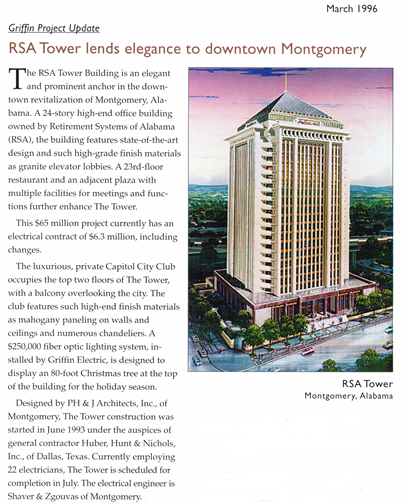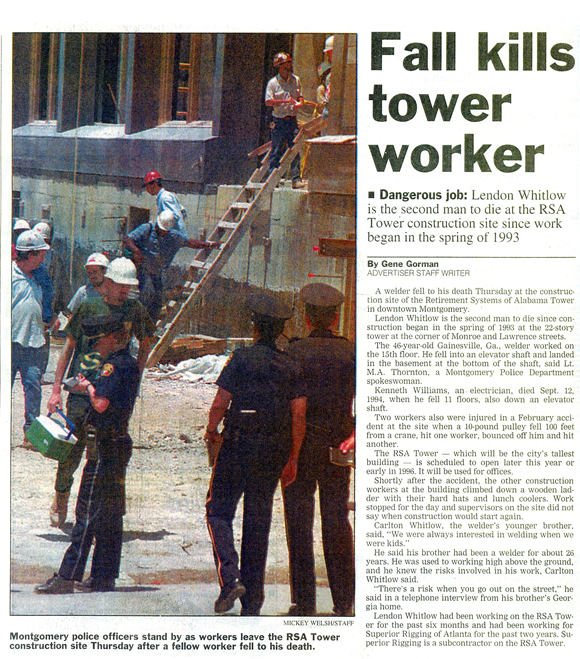Williams
On September 2, 1994, when the structure had reached 16 stories, one Kenneth Williams fell to his death down the main elevator shaft. At that point the safety platforms in the shafts had been removed to allow installation of the elevator separator beams. The wide-open shafts were guarded on each floor by two strands of slack cable, quite easy to step over or through.
Williams, an employee of Wayne Griffin Electric, was working on the twelfth floor and apparently stepped inside the cable barricade without donning his safety harness. He fell all the way to the sub-basement, a 14-floor drop, landing onto the famous J-cap which formed the floor at that level.
HH&N quickly tightened up the safety cables, swept the floors, posted safety signs, etc., before the OSHA team could reach the site. My three guys rushed up to the 12th floor to inspect the accident scene, a natural reaction. I quickly ordered them to stay away, not get caught in a photograph, to ascertain no knowledge of the cause, and to make no public utterance. PH&J notified its insurance carriers and held its collective breath for the next three years, expecting every day to be named in a legal action over the matter. OSHA did not issue a citation against the contractor, and to my knowledge, no suit was ever filed in connection with the death.
That was fortunate because, relatively speaking, our insurance protection was nowhere near as good as it had been on our other jobs over the preceding ten years. We had increased our E&O coverage to $2 Million in view of the Tower project size, but in comparison to the risk, that was meager. The RSA had determined that it would buy its own insurance package, and it did buy an OCP policy. However, for reasons I have yet to fathom, RSA staunchly refused to add PH&J’s name to the policy, even though it would have added no premium cost. Thus, we only had our E&O coverage and felt somewhat exposed. We did have a hold-harmless rider on the contractors’ liability policy, but after the State Supreme Court overturned our coverage of that type in 1983, that protection afforded us little comfort.
Whitlow
On June 15, 1995, only nine months after Williams fell, one Lendon Lee Whitlow fell to his death down the same elevator shaft. At that time the building had reached its full height and Whitlow was working on the 15th floor installing a floor sill for one of the eight high-speed elevator cars. The man was working in the open shaft, so whatever safety barricade was or was not there was not an issue. He fell all the way to the sub-basement and the separator beams at each floor level made it a messy accident.
Isn’t it ironic that Whitlow, who was a welder and an employee of Superior Rigging and Erecting Company of Atlanta, had survived the perils of erecting the steel roof beams at the top of the building, but then succumbed to the relative safety of the shaft. He was wearing a safety harness but had failed to tie it off. This time the political outcry was too great and OSHA issued a citation against HH&N. Knowing this was the second elevator shaft death, the legal vultures circled. Three weeks later, lawyers and “safety experts” from around the country assembled in Montgomery to inspect the accident site, but Huber-Hunt refused them access to the job.
In response, the plaintiff group filed in Circuit Court and Judge Sally Greenhaw granted their plea to gain access. Exactly two years after the accident, the Birmingham law firm of Hare, Wynn, Newell & Newton filed a wrongful death action for an unnamed amount against HH&N, Dover Elevator Company and individual employees of Superior Rigging. Once more PH&J was named as a fictitious party, based on the allegation that we rushed in after the first accident and “voluntarily undertook to inspect for safety”. However, as noted above, after that first incident, I had the PH&J troops withdraw from safety even further. Thus, there was no basis for such a claim, and our firm was never officially identified as the unknown entity.
I still chuckle over an exchange I had with the Dover Elevator Company’s Birmingham Manager, who could not imagine why Dover was named in the suit. After all, he said, Dover had not even been on the job when the accident happened. The floor sills were not even in their contract. In reply, I insisted that the whole thing was Dover’s fault, inasmuch as no shaft would have been needed but for the elevators. He failed to appreciate my sick humor. I do not know if or how this legal action was settled.
-Charles Humphries (“Peril and Intrigue Within Architecture”)
This is one of many RSA Tower stories. The rest can be found here.


i currently guard this thing overnight. alone. my pops just told me about several more deaths before the original structure was built, when it was torn down, and during construction of what stands there now. he was good friends with a welder that died there. this place creeps me out.